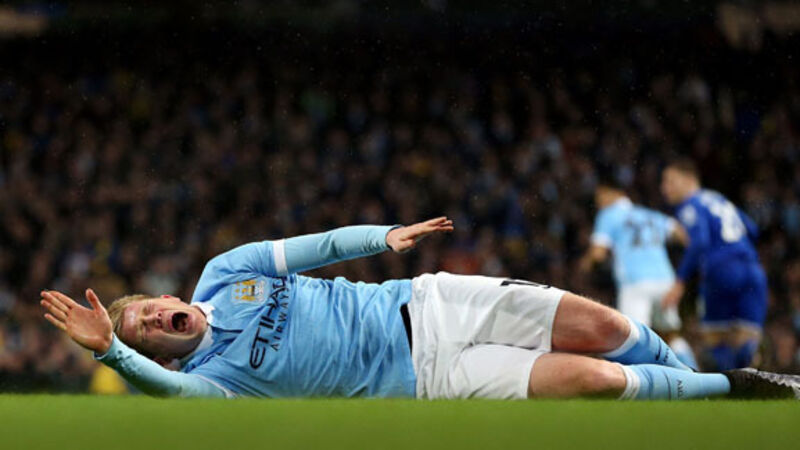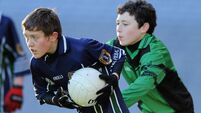Study of injuries in football shows certain trends

He’ll be still less pleased to learn the finest medical minds in football have yet to hit on a solution to the increasing prevalence of ‘hammer’ blows across the game.
Jan Erkstrand, Professor of Sports Medicine at Linkoping University in Sweden, is the Lead Expert in Uefa’s Elite Club Injury Study which, since 2001, has been compiling injury data and identifying trends based on information submitted by some of Europe’s top clubs, including Barcelona, Real Madrid, Bayern Munich, Manchester City, Paris Saint-Germain, Arsenal and Chelsea.
Professor Erkstrand, who is also the First Vice-Chairman of the Uefa Medical Committee, was in Dublin recently to make the keynote address at a sports medicine conference hosted by the Beacon Hospital. And afterwards he explained to me how the Elite Club study has identified that muscle injuries in general, and hamstring problems in particular, are on the increase at the game’s highest level.
“The hamstring injury is also called ‘the spinter’s injury’,” he pointed out, “and in football it usually happens in matches during high- intensity activity. So the fact muscle injuries are increasing could be a reflection of the degree of intensity of the modern game. There have been some studies in the Premier League which suggest the intensity has increased a lot in the last 10 years. If you see old clips from football matches – when I played (laughs) – it’s clear the game is much quicker now. That could be one reason.
“Another reason, which we speculate, is fatigue. Players maybe have too many matches and there is also the risk if the coaches want training to mimic the matches, the training itself is very tough.”
Identifying the problem is one thing, preventing it another matter entirely.
“The fact is we don’t have any very good recommendations to give,” he admitted with disarming candour. “Obviously, the traditional way of strengthening the muscles is not enough so we must look at other things to do. But we don’t have the solution yet.”
Improved lines of communication between the medical and football worlds are key in all this, he believes, but the relationship between the two can sometimes be fraught, as illustrated in the most dramatic fashion on the first day of last season when Jose Mourinho rounded on Chelsea team doctor Eva Carneiro for going onto the pitch to treat Eden Hazard, an incident which blew up into a major controversy and led to her leaving the club. As it happens, Professor Erkstand was one of the expert witnesses for Dr Carneiro in the subsequent constructive dismissal/discrimination case which she took against Chelsea, and for which she later received an apology from the club having agreed a settlement.
“My witness statement was she did nothing wrong, she followed the rules,” he told me. “If the referee calls for you, you must go on and the manager should not interfere with that.”
However, in other injury circumstances, he acknowledges there can be a grey area to be negotiated between a team doctor’s responsibilities to the player and to the manager.
“The basic principle for the doctor is to take care of the safety of the players and that is stated clearly by FIFA and UEFA,” he observed. “But, on the other hand, the doctor must understand a football team is something special, that it’s not like in a hospital.
“So from a medical point of view, if you work in football you could sometimes take risks but never where there may be a sequence of later problems. For example, if you have a muscle injury, the risk you take if you let the player play too early is that they have a re-injury and then it will take a longer time to recover. But it will not give them any problem later in their career or after they have finished playing.
“My opinion is that, in many cases, the role of the doctor is to provide the risk percentage to the manager and then the manager decides. If you say ‘there is a 30% risk of a re-injury and if that happens he will be out for two months’ then you need to accept the manager’s decision, which could depend on the importance of the match or the point in the season.”
But there can be no such calculated risk-taking, he insists, when there is any danger of serious, long-term consequences for the player.
“And that’s why we have this discussion about concussion. Knee ligament is another. Then the doctor has to be the one who decides. There is no way the manager should have a say. It’s purely a medical thing. Because if you break that rule, there is a big risk for later.”
His mention of concussion prompted me to raise the question of whether there could be potential long-term health consequences for footballers from repetitive heading of the ball, a concern which has already seen football authorities in the US ban heading for children under 10. But even in our increasingly health and safety-conscious – not to say litigious – world, Professor Erkstrand is dismissive of the idea that heading could or should ever be outlawed.
“The fact is the problem with head injuries is normally from a clash of heads or an elbow or something like that,” he pointed out. “Heading is not a problem for the trained footballer because they focus on the ball – they are trained how to head it - and we’ve not seen any studies showing heading by footballers, who really are footballers, has any later effects. It’s not like in boxing or something.”
There have also been claims years of heading the ball could be linked to the later onset of brain injury but, the Professor insisted, “you cannot blame one factor for that”.
There could be other causes, he suggested, from genetics to lifestyle issues such as alcohol abuse, “which was a heavy problem 25 years ago - and there is much greater risk of brain problems from that than from heading.
“Football is the biggest sport in the world and if that was the case you would have seen tons former of football players with brain problems. It would be an epidemic. It isn’t.”








